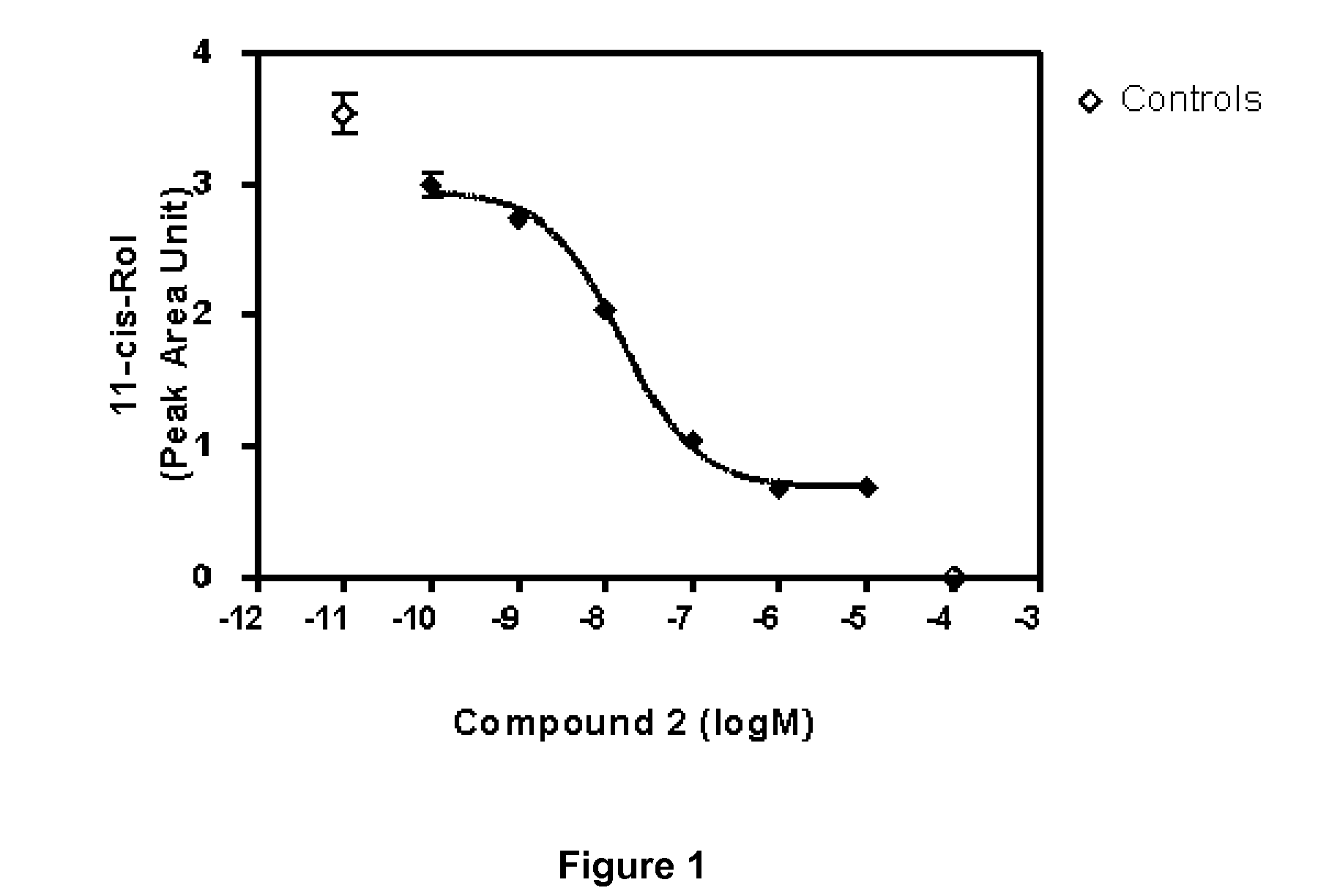Alkynyl Phenyl Derivative Compounds for Treating Ophthalmic Diseases and Disorders
a technology of alkynyl phenyl derivatives and derivative compounds, which is applied in the direction of biocide, cardiovascular disorders, drug compositions, etc., can solve the problems of blind spots in the central vision, damage to the overlying retina, and blindness in aging populations worldwide, so as to reduce the effect of eye ischemia
- Summary
- Abstract
- Description
- Claims
- Application Information
AI Technical Summary
Benefits of technology
Problems solved by technology
Method used
Image
Examples
example 1
PREPARATION OF 1-(3-(3-AMINOPROPYL)PHENYL)-3-ETHYLPENT-1-YN-3-OL
[0730]
[0731]1-(3-(3-Aminopropyl)phenyl)-3-ethylpent-1-yn-3-ol was prepared following the method shown in Scheme 1:
[0732]Step 1: To a stirred solution of 3-(3-bromophenyl)propanoic acid (1) (25.0 g, 109.1 mmole) in CH2Cl2 (150 ml) was added oxalyl chloride (27.7 g, 218.3 mmol) followed by DMF (2 drops). The solution was stirred at room temperature overnight. The resulting mixture was concentrated under reduced pressure to give the crude acid chloride which was used immediately in the next reaction.
[0733]Step 2: The crude material was dissolved in anhydrous THF (150 ml) and cooled in an ice bath. Ammonia gas was bubbled into the solution for 3-4 minutes and the mixture was warmed to room temperature and stirred overnight. The mixture was concentrated under reduced pressure. Saturated NaHCO3 (100 ml) was added to the residue and the mixture was extracted with EtOAc (2×200 ml). The combined organics were dried over Na2SO4 a...
example 2
PREPARATION OF 4-((3-(3-AMINOPROPYL)PHENYL)ETHYNYL)HEPTAN-4-OL
[0738]
[0739]4-((3-(3-Aminopropyl)phenyl)ethynyl)heptan-4-ol was prepared following the method described in Example 1.
[0740]Step 1: Coupling of 4-ethynylheptan-4-ol with bromide 3 gave 2,2,2-trifluoro-N-(3-(3-(3-hydroxy-3-propylhex-1-ynyl)phenyl)propyl)acetamide as a clear oil. Yield (0.103 g, 31%): 1H NMR (400 MHz, DMSO-d6) δ 9.40 (s, 1H), 7.18-7.29 (m, 4H), 3.16 (q, J=7.2 Hz, 2H), 2.56 (t, J=7.2 Hz, 2H), 1.76 (quint, J=7.2 Hz, 2H), 1.53-1.67 (m, 8H), 0.97 (t, J=7.2 Hz, 6H).
[0741]Step 2: To a solution of 2,2,2-trifluoro-N-(3-(3-(3-hydroxy-3-propylhex-1-ynyl)phenyl)propyl)acetamide (0.1 g, 0.27 mmol) in MeOH (3 mL) was added concentrated NH4OH (7 mL) and the solution was stirred at room temperature overnight. The solvent was removed under reduced pressure and the residue was extracted twice with EtOAc. The combined organics were washed with water and brine, dried over Na2SO4 and concentrated under reduced pressure to give ...
example 3
PREPARATION OF 5-((3-(3-AMINOPROPYL)PHENYL)ETHYNYL)NONAN-5-OL
[0742]
[0743]5-((3-(3-Aminopropyl)phenyl)ethynyl)nonan-5-ol was prepared following the method described in Example 1.
[0744]Step 1: Coupling of 3-ethynylnonan-5-ol with bromide 3 gave N-(3-(3-(3-butyl-3-hydroxyhept-1-ynyl)phenyl)propyl)-2,2,2-trifluoroacetamide as a brown oil. Yield (0.346 g, 22%): 1H NMR (400 MHz, DMSO-d6) δ 9.40 (br s, 1H), 7.14-7.26 (m, 4H), 5.11 (s, 1H), 2.56 (t, J=7.6 Hz, 2H), 2.47 (m, 2H), 1.43-1.62 (m, 14H), 0.88 (t, J=7.2 Hz, 6H).
[0745]Step 2: Deprotection of N-(3-(3-(3-butyl-3-hydroxyhept-1-ynyl)phenyl)propyl)-2,2,2-trifluoroacetamide gave Example 3 as a light yellow oil. Yield (0.219 g, 84%): 1H NMR (400 MHz, DMSO-d6) δ 7.22-7.26 (m, 1H), 7.14-7.17 (m, 3H), 5.11 (s, 1H), 2.56 (t, J=7.6 Hz, 2H), 2.49 (t, J=6.8 Hz, 2H), 1.25-1.62 (m, 14H), 0.88 (t, J=7.2 Hz, 6H).
PUM
| Property | Measurement | Unit |
|---|---|---|
| structure | aaaaa | aaaaa |
Abstract
Description
Claims
Application Information
 Login to View More
Login to View More - R&D
- Intellectual Property
- Life Sciences
- Materials
- Tech Scout
- Unparalleled Data Quality
- Higher Quality Content
- 60% Fewer Hallucinations
Browse by: Latest US Patents, China's latest patents, Technical Efficacy Thesaurus, Application Domain, Technology Topic, Popular Technical Reports.
© 2025 PatSnap. All rights reserved.Legal|Privacy policy|Modern Slavery Act Transparency Statement|Sitemap|About US| Contact US: help@patsnap.com



